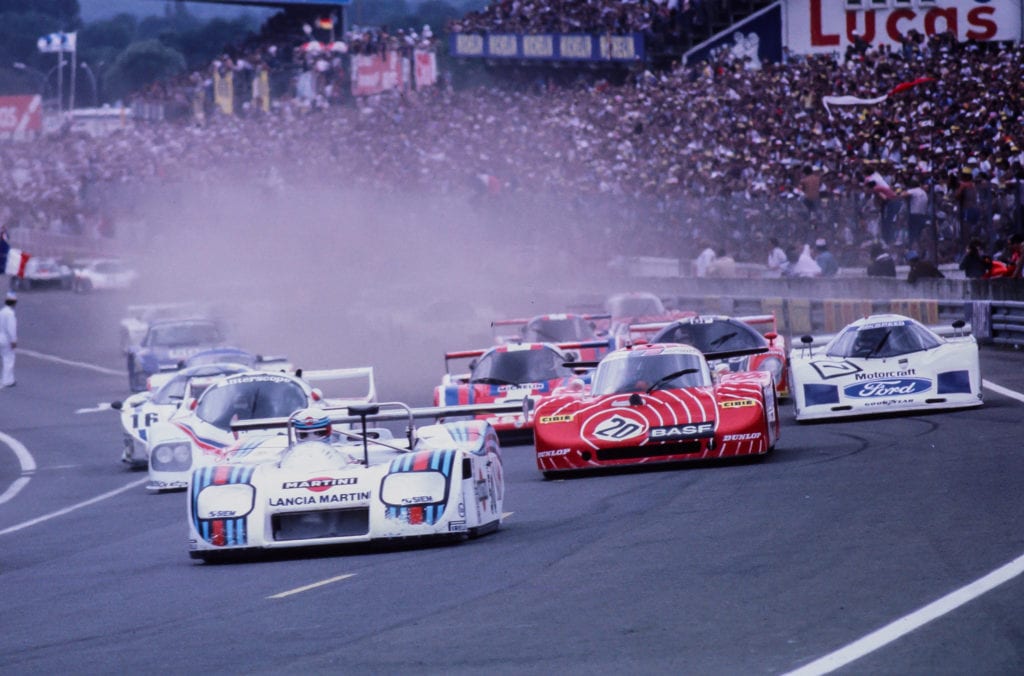Martini & Rossi’s High-Speed Vermouth Billboards

Drinking and driving may be a bad idea, but apparently blending vermouth and auto racing isn’t. For decades, Martini & Rossi, purveyors of not only Italian vermouth but also Asti Spumante sparkling wine, have been splashing its colors over race cars.
Martini & Rossi red and two-tone blue stripes have been a common sight on competition cars. There’s a time-honored allure to those bands, traversing the nose, arching along the sides front to back, aiming straight down the middle or even encircling the door numbers. Instantly recognizable. So much so that Porsche even made a limited run of 911s in 2014 with oversized Martini decals, for sale at your local dealer.
Nine classic race cars sporting the Martini & Rossi livery will be displayed at this year’s Concours d’Elegance in Amelia Island, FL on March 10th. And this raises a question. Why do cars painted with a vermouth corporate logo have more allure and appeal to enthusiasts than, say, cars sporting the logos of Bud Light, Shell, Pennzoil or McDonalds?

“Longevity,” explains English motorsports historian Murray Smith. “The colors and their use are fantastic and so complimentary to the white, silver and red that are usually the base color of their cars.”
Smith adds: “Martini & Rossi sponsorship was consistently seen on the top-running cars that won at Le Mans, the Monte Carlo Rally, Formula 1 and even on offshore powerboats. Burned into history.”
Concours organizer Bill Warner points out there are even famous race cars like some Porsche 917s and 935s that are specifically remembered not as Porsches but as Martini & Rossi 917s and 935s. Italian vermouth, it seems, just has more panache than hamburgers.
The vermouth maker literally started small, with “Martini & Rossi Racing Team” lettering on the front wheel arches of two Alfa Romeos at the 1973 3-hour Daytona Continental. Now the blue-and-red Martini banding flows from nose to tail on the 2018 Williams FW41 Formula 1 cars that Lance Stroll and Sergey Sirotkin will race in 2018.

While beer might be the favored sponsor alcoholic beverage in U.S. racing, Martini & Rossi — now owned by Bacardi — resonates with the international crowd. It’s estimated some 4 million spectators worldwide attend a season’s Grand Prix races, while some 400 million watch on TV.
Autosport magazine says 92% of fans are male with 59% age 18-40. Given Martini’s long-standing sponsorship, perhaps the 37% age 40 and up are nostalgic about the Martini stripes. The company’s long-term faith in sponsoring motorsports has been neither shaken nor stirred.
At this year’s Amelia Island Concours, nine Martini & Rossi-sponsored sports racing and rally cars will be on display. Among them are half a dozen Lancias owned by John Campion, who learned to love that marque while growing up in Ireland. Here’s a list of the nine:








Lastly, a Martini & Rossi striped Lancia Delta Integrale will be on the field. This was easily Lancia’s most successful rally car, winning the World Rally Championship manufacturer’s title from 1987-1992 plus four driver’s titles.

Today’s Williams sponsorship isn’t Martini & Rossi’s first foray into Formula 1. After lackluster seasons with the Techno team in 1972 and 1973, Martini money went to Brabham. The Gordon Murray-designed white Cosworth V-8 BT44s and red Alfa flat-12 BT45s were Martini’s team in 1975-77. Moving to Lotus, Martini paid to play for one year, 1979, and had a small label on Ferrari’s 2006 F1 car. Since 2014, the vermouth maker’s stripes have snaked over the nose and back to the tail of Williams’ F1 cars.